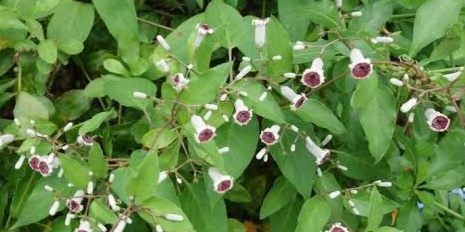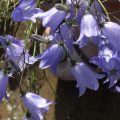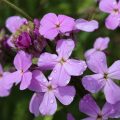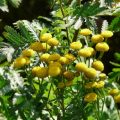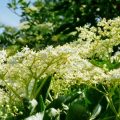- The Miraculous Shiny Bush Plant - January 18, 2021
- Colorful, Edible and Medicinal Celosia - January 10, 2021
- Radish, a Nutritional Power House - December 19, 2020
Paederia Foetida, commonly known as skunk vine, stink vine, or Chinese fever vine, is a slender climbing vine that scrambles over other plants for support. It is native to Asia and thrives in temperate and tropical regions. The plant has oblong or ovate leaves that grow opposite each other. Blossoms are lilac or pink with five petals.
[Note: The Right Flowers is not a medical site. Knowledge of and information about the therapeutic benefits and applications of flowers, while known through the ages, does not constitute medical advice. If you are having health issues, you should consult with a physician.]
The plant was imported from Asia to the US in the 1890s for fiber purposes. But in less than two decades, the plant had become noxious due to its invasive tendencies. By 1916, the vine was already invading hedgerows and colonizing other disturbed places. With such a history, it is important to control the spread of the skunk vine by both chemical and physical methods, plus a lot of patience.
The word paederia is borrowed from the Greek word paederos meaning opals, probably due to some varieties that produce translucent fruits. However, a different school of thought says that paederia is derived from the Latin word paedor meaning stinky, stench, or filth. Meanwhile, foetida is medieval Latin meaning stinky or smelly.
In Japan, they refer to it as fart vine, while in China it is commonly known as chicken shit vine. So much hate for one plant, right? In spite of the bad publicity the plant has received over the years, some people say that its smell is more tolerable compared to Momordica charantia (bitter lemon) or passafloria laurifolia (passionflower).
So, what causes the skunk-like odor of the stinky vine? The odor is attributed to the presence of carbon disulfide ((CS2), a highly volatile compound that is often associated with the bad odor of the plant, and most evident in the leaves. Most people actually become aware of the plant when they break or crush its leaves and they get assaulted by the sulfur-like odor.
In spite of its foul smell and invasive tendencies, the skunk vine has many herbal qualities. The plant is antidiarrhoea, antiviral, anti-tussive, anti-cancer, anti-inflammatory, and anti-tussive. Most of the plant’s herbal properties are found in its leaves and flowers. These beneficial compounds include amino acids, sitosterol, carbohydrates, flavonoids, ascorbic acid, alkaloids, glycosides, and volatile oils.
A paste is made by crushing the whole plant, which is then steeped in boiling water, strained to remove debris, and then mixed with sesame oil. The mixture is cooked until it forms a thick paste which is applied externally to relieve muscular pain, neuralgia, and joint pain.
Apart from having medicinal qualities, the skunk vine has been cultivated for ornamental reasons in the past. In full foliage and bloom, especially in summer when it flowers, the plant looks very attractive.
Here is a great plant with many beneficial compounds. However, its invasiveness and skunky odor make it a nuisance to cultivate.
